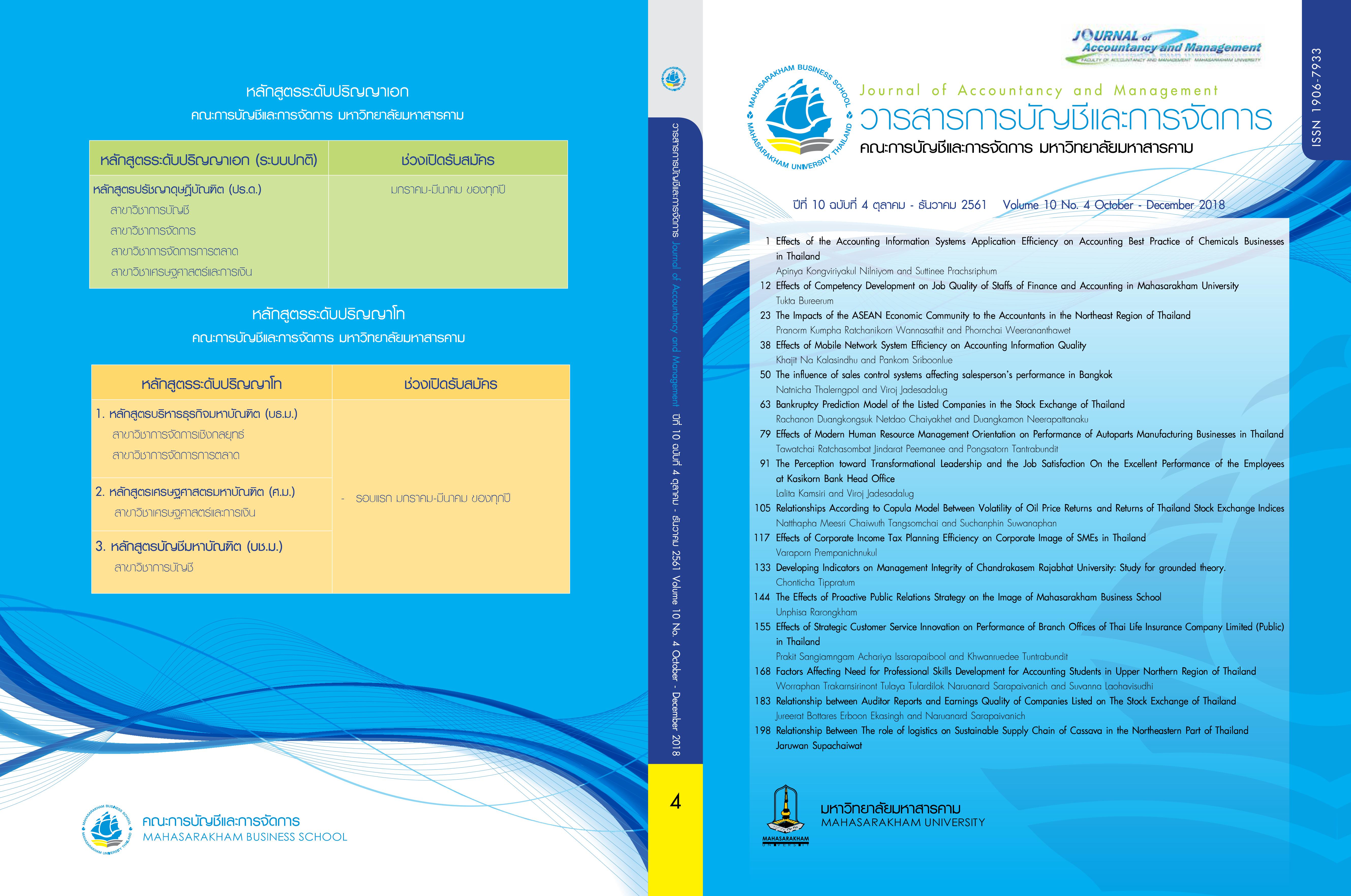แบบจำลองการพยากรณ์ภาวะล้มละลายของบริษัทจดทะเบียนในตลาดหลักทรัพย์แห่งประเทศไทย
Main Article Content
บทคัดย่อ
งานวิจัยนี้มีวัตถุประสงค์เพื่อสร้างแบบจำลองสำหรับการพยากรณ์โอกาสที่จะเกิดการล้มละลายของบริษัทที่จดทะเบียนในตลาดหลักทรัพย์แห่งประเทศไทยเพื่อช่วยให้นักลงทุนหรือผู้มีส่วนได้เสียกับกิจการใช้ในการวิเคราะห์ความมั่นคงของบริษัท โดยใช้เทคนิควิเคราะห์จำแนกประเภท กลุ่มตัวอย่างถูกแบ่งเป็นสองกลุ่มคือบริษัทที่มีภาวะล้มละลาย (Bankruptcy) เลือกจากบริษัทที่เข้าข่ายถูกเพิกถอนจากตลาดหลักทรัพย์แห่งประเทศไทยระหว่างปี 2554 – 2559 จำนวน 18 บริษัทและบริษัทที่ไม่มีภาวะล้มละลาย (Non-bankruptcy) จำนวน 58 บริษัท โดยเลือกจากบริษัทที่ถูกจัดประเภทอยู่ในกลุ่มอุตสาหกรรมเดียวกัน และมีสินทรัพย์รวมใกล้เคียงกัน โดยเป็นช่วงเวลาก่อนที่บริษัทจะเข้าข่ายถูกเพิกถอนจากตลาดหลักทรัพย์แห่งประเทศไทย ผลการศึกษาพบว่าสำหรับแบบจำลองในช่วงเวลา 1 ปีก่อนเข้าสู่ภาวะล้มละลาย ตัวแปรที่สามารถพยากรณ์และจำแนกกลุ่มได้มีทั้งสิ้น 5 ตัวแปร ได้แก่ อัตรากำไรขั้นต้น อัตราผลตอบแทนจากส่วนของผู้ถือหุ้น อัตราส่วนเงินทุนหมุนเวียนต่อสินทรัพย์รวม ความเห็นในรายงานของผู้สอบบัญชีต่องบการเงินและสัดส่วนของผู้ถือหุ้นรายใหญ่ 5 ลำดับแรก และเมื่อพิจารณาข้อมูลในช่วงเวลา 2 ปีก่อนเข้าสู่ภาวะล้มละลายตัวแปรที่สามารถพยากรณ์และจำแนกกลุ่มได้มีทั้งสิ้น 4 ตัวแปร ได้แก่ อัตรากำไรขั้นต้น อัตราผลตอบแทนจากสินทรัพย์รวม อัตราผลตอบแทนจากส่วนของผู้ถือหุ้น และความเห็นในรายงานของผู้สอบบัญชีต่องบการเงิน ผลการทดสอบความแม่นยำของแบบจำลองที่ได้ทั้งสองช่วงเวลา พบว่า มีความสามารถในการพยากรณ์ถูกต้องโดยรวมเท่ากันอยู่ที่ 92.1%
Downloads
Article Details
บทความที่ได้รับการตีพิมพ์เป็นลิขสิทธิ์ของวารสารการบัญชีและการจัดการ
ข้อความที่ปรากฏในบทความแต่ละเรื่องในวารสารวิชาการเล่มนี้เป็นความคิดเห็นส่วนตัวของผู้เขียนแต่ละท่านไม่เกี่ยวข้องกับมหาวิทยาลัยมหาสารคาม และคณาจารย์ท่านอื่นๆในมหาวิทยาลัยฯ แต่อย่างใด ความรับผิดชอบองค์ประกอบทั้งหมดของบทความแต่ละเรื่องเป็นของผู้เขียนแต่ละท่าน หากมีความผิดพลาดใดๆ ผู้เขียนแต่ละท่านจะรับผิดชอบบทความของตนเองแต่ผู้เดียว
เอกสารอ้างอิง
ได้เปรียบทางการแข่งขันของบริษัทในนิคมอุตสาหกรรมการผลิตแห่งประเทศไทย. วารสารการบัญชีและ
การจัดการ มหาวิทยาลัยมหาสารคาม. 6(4), 146-162.
กัลยา วานิชย์บัญชา. (2551). การวิเคราะห์ตัวแปรหลายตัวด้วย SPSS for Windows. กรุงเทพฯ: จุฬาลงกรณ์มหาวิทยาลัย.
คณะกรรมการมาตรฐานการบัญชี. (2544). คู่มืออธิบายมาตรฐานการบัญชี ฉบับที่37 (ปรับปรุง 2558). กรุงเทพฯ: อมรินทร์พริ้นติ้งแอนด์พับลิชชิ่ง.
จีรนันท์ เขิมขันธ์ และ สุรชัย จันทร์จรัส. (2556). เครื่องมือพยากรณ์ความล้มเหลวทางการเงิน. วารสารนักบริหาร, 33(4), 34-41.
ณัฎฐยา เพชรล่อเหลียน. (2553). การศึกษาความสัมพันธ์ระหว่างโอกาสในการล้มละลายและการตกแต่งกำไรของของบริษัทจดทะเบียน
ในตลาดหลักทรัพย์แห่งประเทศไทย.วิทยานิพนธ์บัญชีมหาบัณฑิต, สาขาวิชาการบัญชี, คณะพาณิชยศาสตร์และการบัญชี, มหาวิทยาลัยธรรมศาสตร์.
ณัฐณิชา อร่ามเธียรธำรง. (2554). การพยากรณ์ความล้มเหลวทางการเงินของบริษัทจดทะเบียนในตลาดหลักทรัพย์.
การศึกษาอิสระวิทยาศาสตรมหาบัณฑิต, สาขาวิชาการบริหารการเงิน, คณะพาณิชยศาสตร์และการบัญชี,
มหาวิทยาลัยธรรมศาสตร์.
ทรงศักดิ์ ภูสีอ่อน. (2551). การประยุกต์ใช้ SPSS วิเคราะห์ข้อมูลงานวิจัย. กาฬสินธุ์: ประสานการพิมพ์.
ธนิดา จิตร์น้อมรัตน์. (2542). การจัดการการเงิน, กรุงเทพฯ: มหาวิทยาลัยธุรกิจบัณฑิตย์.
ประเสริฐ ลีฬหาวาสน์ และมนวิกา ผดุงสิทธิ์. (2552). การพยากรณ์ภาวะล้มเหลวทางธุรกิจจากข้อมูลทางบัญชี.
วารสารวิชาชีพบัญชี, 5(13), 65-82.
ปานรดา พิลาศรี และ มนวิกา ผดุงสิทธิ์. (2554). แบบจำลองการพยากรณ์ภาวะล้มเหลวทางการเงินวิธีวิเคราะห์
จำแนกประเภท. วารสารวิชาชีพบัญชี, 7(18), 25-42.
ไพรินทร์ ชลไพศาล. (2557). รายงานการวิจัยสัญญาณเตือนภัยทางธุรกิจกรณีศึกษาบริษัทจดทะเบียนในตลาด
หลักทรัพย์แห่งประเทศไทย. กรุงเทพฯ: คณะเศรษฐศาสตร์, มหาวิทยาลัยธุรกิจบัณฑิตย์.
สมประสงค์ เสนารัตน์. (2553). การจำแนกกลุ่มด้วยเทคนิค Discriminant Analysis. ดุษฎีนิพนธ์ปรัชญาดุษฎีบัณฑิต,
สาขาวิชาวิจัยและประเมินผล, คณะศึกษาศาสตร์, มหาวิทยาลัยมหาสารคาม.
อภิญญา อดทน. (2553). การเปรียบเทียบความสามารถของแบบจำลองเพื่อทำนายภาวะล้มเหลวทางการเงินแบบ Altman’s Z-Score Model
และ Zmijewski Model ของบริษัทจดทะเบียนในตลาดหลักทรัพย์. วิทยานิพนธ์บัญชีมหาบัณฑิต, สาขาวิชาการบัญชี,
คณะพาณิชยศาสตร์และการบัญชี, มหาวิทยาลัยธรรมศาสตร์.
เอกสิทธิ์ เข้มงวด. (2554). การศึกษาความแม่นยำ และพัฒนาตัวแบบ Altman’s EM-Score Model สำหรับการพยากรณ์ความล้มเหลวทางการเงินของ
บริษัทจดทะเบียนในตลาดหลักทรัพย์แห่งประเทศไทย. วิทยานิพนธ์บริหารธุรกิจมหาบัณฑิต, สาขาวิชาบริหารธุรกิจ, บัณฑิตวิทยาลัย, มหาวิทยาลัยกรุงเทพ.
Altman, E. I. (1968). Financial ratios, discriminant analysis and the prediction of corporate bankruptcy.
Journal of Finance, 23, 589-609.
Altman, E., & Izan, H. (1984). Identifying corporate distress in Australia: An industry relative analysis.
(Working paper). New York: Baruch College, The City University of New York.
Beaver, W. H. (1966). Financial ratios as predictors of failure. Journal of Accounting Research, 56(5), 71-111.
Christine, E. L. (2002). The asymmetric information content of going–concern opinions–evidence form
bankrupt firms with and without prior distress indicators. (Working paper). New York: Baruch
College, The City University of New York.
Chletsos, M., Mazetas, D., Kotrotsiou, E., & Gouva, M. (2013). The effect of unemployment on mental
health. European Psychiatry, 28(1), 1-10.
Deakin, E. B. (1972). A discriminant analysis of predictors of business failure. Journal of Accounting
Research, 13(56), 167-179.
Feldesman, M. R. (2002). Classification trees as an alternative to linear discriminant analysis. The Official
Journal of the American Association of Physical Anthropologists, 119(3), 257 275.
Hinkle, D. E, William ,W., & Stephen G. J. (1998). Applied Statistics for the Behavior Sciences (4th ed.).
New York : Houghton Mifflin.
Platt, H. D., & Platt, M. B. (2006). Comparing financial distress and bankruptcy. Review of Applied
Economics, 2(2), 53-72.
Ohlson, J. A. (1980). Toward a theory of financial accounting. Journal of the American Finance
Association, 35(2), 537 – 547.
Platt, H. D., & Platt, M. (2006).Comparing financial distress and bankruptcy. Review of Applied
Economics, 2(2), 153-160.
Tan, C. E. L. (2002). The asymmetric information content of going–concern opinions– evidence form
bankrupt firms with and without prior distress indicators. (Working paper). New York: Baruch
College, The City University of New York.
Wilson, R. L., & Sharda, R. (1994). Bankruptcy prediction using neural networks. Journal Decision Support
Systems, 11(5), 545-557.


